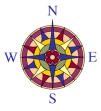| Added_person: Kool, Jan |
| Local_note: Plate 29 of the Atlas accompanying Georges Henri Victor Collot's notes on his (spurious?) Journey was impressed from the same basic etched plate as map 2307. This, lacking either title or proper names for any of its topographical features, had been used by a group or groups of English explorers of western North America in 1786-1789--notably Alexander Mackenzie on his probe from Great Slave Lake NNW to Latitude 69 degrees, 1 minute, on the Arctic Ocean--to enter the record of their observations, probably on location. The added place names, including tribal identities and territories, having thus been entered by hand on the printed sheet, this made its way back to Europe, where it served as the source of nomenclature and information for the map impression which is represented in Plate 29 of Collot's 1826 Atlas. This later impression is thus a composite of an earlier, "blank" topographic image and subsequently added, and corrected, lettering. Several mistakes arise in the transitions between the two or three sequential versions in French and English, the final language of Plate 29 in the Atlas companion to Collot's Journey, NYHS library call number *Y/1826/.C. |
| General_note: The ms. title has been rewritten, with changes; chief among these is the crossing out of the following statement: "Drawn up, to give an Idea of the state of the Country, and serve for the Discovery's made to the West North West and upper and Lower Louisiana in 1796." |
| Local_note: The watermark of map 2307 appears to be a rampant lion, most of which is still visible above the lettering "J[an] Kool" (a Dutch papermaker, 1728-1800) at the top center of the sheet. The watermark of Plate 29 is simply "b & b," which may designate the Dutch firm of Blauw & Briel, operating from mills in Wormerveer and Zaandyk between 1724 and 1825. |
| General_note: verso note: "Carte du Missouri et Mississipi par Cha. s [?]" |
| Extent: 1 printed map with mss additions |
| Added_date: 1792 |
| Dimensions: 60 x 49 cm. |
| Medium: black ink, with hand-annotations in dark and in lighter brown ink and graphite pencil, on chain-and-laid, watermarked paper backed with cloth |
| Added_person: Collot, Georges Henri Victor |
| Local_note: pencil note, UL: "Paris: Sept 1871 Bought by G.H.M. [probably George H. Moore, Assistant Librarian of the New York Historical Society] Compare Map No. 29 in the Atlas to [Georges Henri Victor] Collot's Journey in America [i.e. A journey in North America (Paris, 1826)]": NYHS library catalogue number *Y/1826/.C. See Local Note 2, below. |
| General_note: This map was originally printed "blank," without lettering for the topographical features; it has been extensively hand-annotated and -corrected to record the discoveries of 1786-1789 British exploratory expeditions as well as to designate the drainage patterns of the Great Divide. Sir Alexander Mackenzie (1755?-1820) set out on June 3, 1789, and reached the Arctic Ocean on July 12, 1789, at the effluence of what is now the Mackenzie River into the Beaufort Sea. See the hand-entered notes in the upper left portion of the map, particularly the correction indicating the northernmost reach of the Rocky Mountains chain. This and other ms. notes were inculcated into a later impression of the basic etched plate; see NYHS library catalogue number *Y/1826/.C, atlas Plate 29. |

